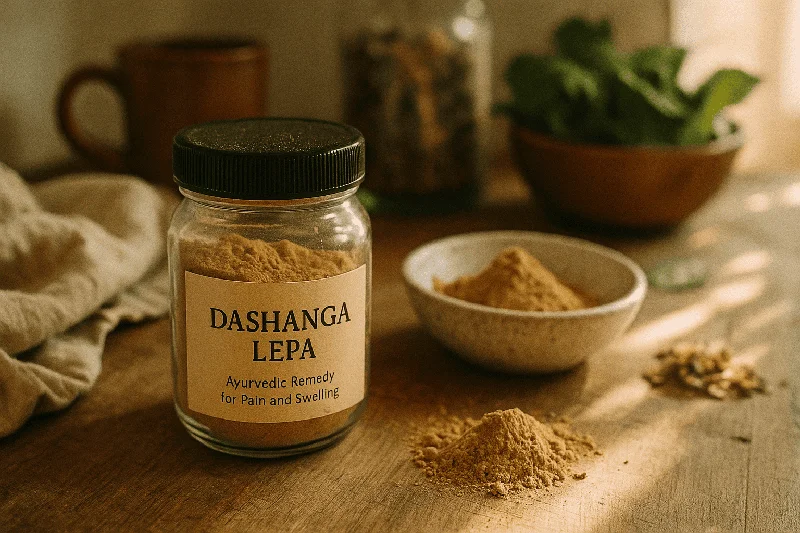Ask Ayurvedic doctor a question and get a consultation online on the problem of your concern in a free or paid mode. More than 2,000 experienced doctors work and wait for your questions on our site and help users to solve their health problems every day.
Shop Now in Our Store
Dashanga Lepa Uses: Ayurvedic Remedy for Pain and Swelling

Introduction to Dashanga Lepa
Dashanga Lepa is a traditional Ayurvedic herbal paste formulated from ten potent herbs. Used externally, this lepa (paste) is renowned for its effectiveness in relieving pain, reducing inflammation, and promoting skin health. Rooted in classical Ayurvedic practice, Dashanga Lepa is applied topically to balance doshas, ease musculoskeletal discomfort, and support overall well-being.
Historical Roots & Ayurvedic Significance
The term "Dashanga" means "ten limbs" or "ten parts," referring to the combination of ten herbs that form the core of this formulation. Ancient Ayurvedic texts describe lepa as a vital external therapy that helps in detoxifying tissues, improving circulation, and restoring balance among the doshas. Dashanga Lepa, with its unique blend of ingredients, exemplifies Ayurveda’s holistic approach to treating localized pain and skin conditions while promoting harmony within the body.
Key Components & Therapeutic Benefits
1. Herbal Composition
Dashanga Lepa typically contains a blend of ten herbs such as:
- Shallaki (Boswellia serrata): Known for its anti-inflammatory properties.
- Guggulu (Commiphora mukul): Supports joint health and reduces swelling.
- Turmeric (Curcuma longa): Provides antioxidant and antimicrobial effects.
- Other Complementary Herbs: Each herb contributes specific benefits, enhancing the overall efficacy of the paste.
2. Pain Relief & Anti-inflammatory Effects
The combination of herbs in Dashanga Lepa works synergistically to:
- Reduce Inflammation: Herbs like Shallaki and Turmeric alleviate swelling and redness.
- Relieve Pain: Applied on joints and muscles, it provides soothing relief from arthritis, rheumatism, and general body aches.
- Improve Mobility: By reducing stiffness, the lepa aids in restoring movement and flexibility.
3. Skin Health & Healing
Apart from musculoskeletal benefits, Dashanga Lepa is used for skin-related concerns:
- Wound Healing: Its antimicrobial properties help in preventing infections and promoting faster healing of minor cuts and abrasions.
- Eczema and Dermatitis: The soothing herbs calm irritation and reduce inflammation on the skin.
- Detoxification: Regular application can help remove toxins from the skin, improving complexion and texture.
4. Dosha Balancing
Dashanga Lepa primarily balances Vata and Kapha doshas, which are often responsible for pain and stagnation in the body. By harmonizing these doshas, the paste promotes circulation and energy flow, aiding in faster recovery from injuries and chronic conditions.
How to Use Dashanga Lepa
Preparation & Application:
- Cleanse the Area: Ensure the skin is clean and dry before application.
- Apply the Paste: Using clean hands or a brush, apply a thin layer of Dashanga Lepa on the affected area.
- Massage Gently: Massage the paste into the skin in circular motions to enhance absorption and stimulate circulation.
- Leave On: Allow the lepa to dry and remain on the skin for 20-30 minutes.
- Remove & Cleanse: Gently wash off with lukewarm water and pat dry.
Frequency & Duration:
- For acute pain or inflammation, apply Dashanga Lepa 2-3 times daily.
- For chronic conditions, consistent application over several weeks may be necessary, as advised by an Ayurvedic practitioner.
Potential Side Effects & Precautions
- Allergic Reactions: Always perform a patch test on a small skin area to check for sensitivity.
- Skin Irritation: If redness or irritation occurs, discontinue use and consult a healthcare professional.
- Not for Open Wounds: Avoid applying on broken skin or open wounds unless directed by a practitioner.
Frequently Asked Questions (FAQ)
What conditions can Dashanga Lepa treat?
Dashanga Lepa is effective for relieving joint and muscle pain, reducing inflammation, treating arthritis, easing skin conditions like eczema, and promoting wound healing.
How often should I apply Dashanga Lepa?
The frequency depends on the condition being treated. Generally, 2-3 applications per day for acute pain and regular use over weeks for chronic issues are recommended, under practitioner guidance.
Can I use Dashanga Lepa on sensitive skin?
Perform a patch test first to ensure no allergic reaction. If sensitivity occurs, discontinue use.
Where can I buy authentic Dashanga Lepa?
It can be purchased from certified Ayurvedic pharmacies, reputable herbal stores, or through recommendations from qualified Ayurvedic practitioners.
Is Dashanga Lepa safe for long-term use?
When used as directed by an Ayurvedic practitioner, it is safe for long-term use. However, ongoing supervision ensures proper application and monitoring of results.
Conclusion & Expert Insights
Dashanga Lepa stands as a testament to Ayurveda's profound understanding of natural healing. Through its blend of ten potent herbs, this herbal paste effectively addresses pain, inflammation, and skin issues while promoting overall wellness. Incorporating Dashanga Lepa into a holistic self-care routine, guided by expert advice, can lead to significant improvements in quality of life and physical comfort. As with all Ayurvedic treatments, personalized guidance from a qualified practitioner ensures maximum benefits and safety.
References & Further Reading
- Lad, V. (1984). Ayurveda: The Science of Self-Healing. Lotus Press.
- Frawley, D. (1999). Ayurvedic Healing: A Comprehensive Guide. Lotus Press.
- Chopra, D., et al. (2002). "Ayurveda: A Historical Perspective and Principles of Natural Healing." Journal of Alternative and Complementary Medicine, 8(5), 495-502.
- National Institute of Ayurveda. Retrieved from
This article is checked by the current qualified Dr. Abhishek Gautam and can be considered a reliable source of information for users of the site.

